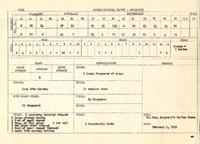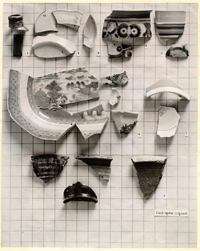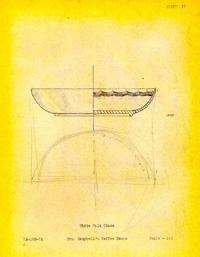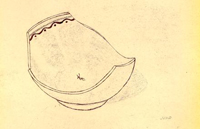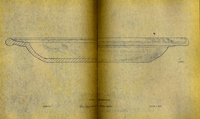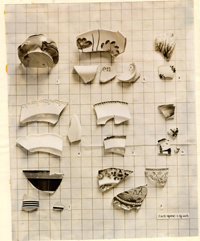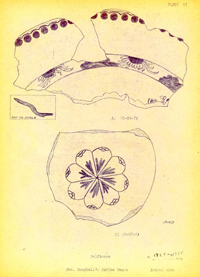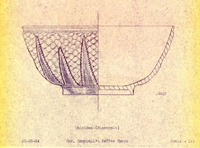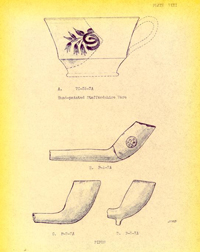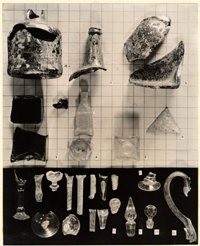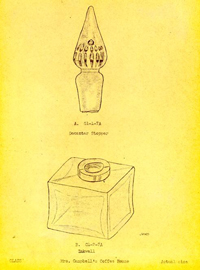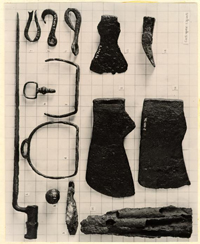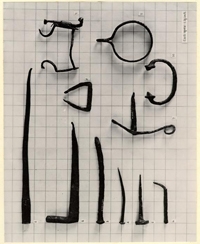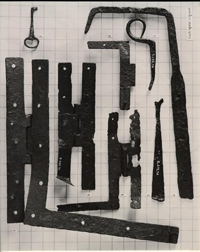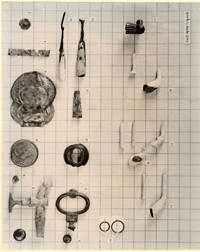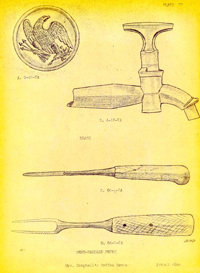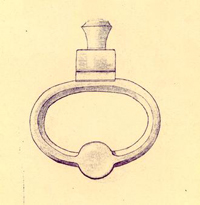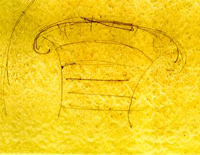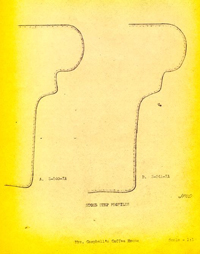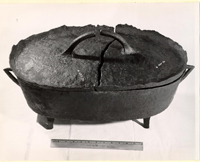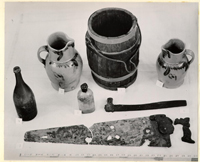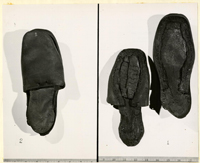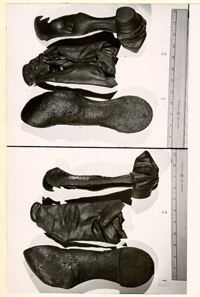Christiana Campbell's Tavern Archaeological Report, Block 7 Building 45 Lot 20, 21, 22Originally entitled: "Mrs. Campbell's Coffee House,Block 7, Parts of Colonial Lots Numbered 20, 21 and 22, Archaeological Area 7A"
Colonial Williamsburg Foundation Library Research Report Series - 1099
Colonial Williamsburg Foundation Library
Williamsburg, Virginia
1990
MRS. CAMPBELL'S COFFEE HOUSE
BLOCK 7
PARTS OF COLONIAL LOTS NUMBERED 20, 21, and 22, ARCHAEOLOGICAL AREA 7A
WILLIAMSBURG, VIRGINIA
ARCHAEOLOGICAL LABORATORY REPORT
Office of Architectural Research Office
Colonial Williamsburg
FEBRUARY 1, 1955
PREFACE
The following is a report prepared in the Archaeological Laboratory upon the artifacts recovered from the site of Mrs. Campbell's Coffee House (7A), in response to a request from the Curator.
The artifacts were excavated under the direction of Mr. James M. Knight, Archaeological Draftsman, except for those objects recovered in June 1954, during the exploration of a well on this lot by workers supervised by Archaeological Laboratory personnel. A brief report of the well cleaning project forms an appendix to this report.
Illustrations are the work of Mr. David Brooks and Mr. George Beamish, Photographers, and of Mr. John V. E. Dunton, Archaeological Treatment Assistant in the Laboratory.
TABLE OF CONTENTS
| Preface | 2 |
| Table of Contents | 3 |
| Introduction | 5 |
| Key to Statistical Artifact Report | (facing) 7 |
| Statistical Artifact Report | 7 |
| Comments on Ceramics | 8 |
| Plate I | |
| Class 1A, Brown Stoneware | 8 |
| Class 2A, White Salt Glaze Stoneware | 8 |
| Plate II | |
| Class 3A, Gray Stoneware | 9 |
| Class 1B, Chinese Porcelain | 9 |
| Class 2B, Chinese Porcelain (polychrome enameled) | |
| Plate III | |
| Class 1C, Crude Earthenware | 10 |
| Plates IV and V | |
| Class 2C, Slipware | 10 |
| Class 3C, Delftware | 11 |
| Plate VI | |
| Class 4C, Whieldon Ware | 11 |
| Plate VII | |
| Class 5C, Creamware | 12 |
| Class 6C, Blue- and Green-Edged Ware | 12 |
| Class 7C, Hand-Painted Staffordshire Ware | 12 |
| 4 | |
| Plate VIII | |
| Class 8C, Annular Ware | 13 |
| Class 9C, Transfer-Printed Staffordshire Ware | 13 |
| Comments on Glass | 14 |
| Plates IX and X | |
| Comments on Metal | 15 |
| Inventory of Iron Material | 16 |
| Plates XI, XII, and XIII | |
| Inventory of Brass and Bronze Material | 20 |
| Plates XIV, XV, and XVI | |
| Description of Object of Miscellaneous Metal (Pewter) | 22 |
| Comments on Stone | 22 |
| Plate XVII | |
| Comments on Brick | 23 |
| Description of Tobacco Pipes | 24 |
| Description of Bone-Handled Cutlery | 25 |
| APPENDIX: Excavation of Well | 26 |
| Plates XVIII, XIX, XX and XXI | |
INTRODUCTION
This report upon the artifacts found in Archaeological Area 7A is the second formal descriptive report prepared by the staff of the Archaeological Laboratory, the first having related to the Archibald Blair Storehouse Site, designated as Archaeological Area 18C.
[Illegible hand-written notes in margin]
The first structure known to have stood on this lot was a play-house erected about 1751 or 1752 by Alexander Finnie, tavern-keeper of The Raleigh. A year later, the celebrated comedian, Lewis Hallam, altered the structure to a theatre, the second to stand in Williamsburg. Between 1754 and 1757 this had made way for a good dwelling, at least fifty by twenty feet in dimensions, built by John Stretch, a bookbinder at (Hunter's) Virginia Gazette. From 1765 to 1771, Nathaniel Walthoe and his estate held title to the building, while Mrs. Jane Vobe, as tenant, operated a coffee house or tavern here. Incidentally, its porch on October 30, 1765, was the place where a throng of indignant Virginians "persuaded" Colonel George Mercer to defer enforcement of the detested Stamp Act in Virginia. In 1771, Mrs. Christianna Campbell took over operation of the coffee house and purchased the property in 1774. George Washington is known to have taken his meals here on many visits to the seat of government. For a considerable period Mrs. Campbell continued to maintain a public house, although she had discontinued operating it as such for some years prior to 1783. It, however, remained her residence until her death in 1792, and in the hands of her estate until 1798. Thomas Sands was the owner for about a decade onward from 1801; during at least a portion of this time a blacksmith's shop stood about twenty feet north of the residence. In 1815 Edmund Christian was the owner, but by 1822 the property had come, once more, into the possession of a Benjamin Waller, and it remained in Waller ownership until 1886. The old tavern, or coffee house, was burned about 1859, and a new structure was built on the site. From 1886, and until Colonial Williamsburg, Incorporated, purchased the land on which a modern residence was standing in 1939, this property had belonged in succession to Moses R. Harrell (1886-1890), P. M. Thompson (1890-1894), and to L. W. Lane (1894-1920), whose grand-daughter, Mrs. Lucy Lamb Kelly, was the last individual owner.
Quantities of debris, identified with the Middle and Late Nineteenth Century, were found on this site. For example, significant numbers of railroad spikes and related material from the latter half of the Nineteenth Century were found throughout this and adjacent lots. These finds, and the fact that the soil of this area showed a considerable disturbance, are tangible reminders that a temporary railway, which ran down the center of the Duke of Gloucester Street in the early 1880's in connection with a Jamestown Celebration of that year, had been laid close to, if not immediately across this lot. In consequence 6 of the great disturbance of this area during the latter half of the Nineteenth Century, the artifacts from this site which are identifiable with the Eighteenth and early Nineteenth Centuries represent a relatively small proportion of the total findings.
This site has produced but little ceramic material for the period earlier than the middle of the Nineteenth Century. Most of what has been recovered represents types that came into use during the late Eighteenth and Early Nineteenth Centuries; few ceramic evidences exist that identify this site with earlier years. Furthermore, it is significant that the artifacts which have been found at this location, whether whole or in pieces - whether ceramic, glass, or metal -, are distinctive of no particular trade or occupation. These finds might with equal appropriateness have been encountered on a lot occupied exclusively by a dwelling as on one known reliably to have been for some years the seat of a "public house".
A tabular, statistical evaluation of the quantities of artifacts found here precedes the qualitative, and in many cases detailed description of the ceramic, metal, glass, and stone portions of this collection. Objects have been considered by categories to which the statistical tabulation serves as the key. Photographs and carefully prepared drawings embellish the report and are identified in the text.
An appendix supplies notes upon the excavation of the well upon this site and the objects recovered from it. Such perishable materials as wood, leather, and textiles were recovered from the water-logged depths of this well. Much of the material is of great interest.
Appreciation is expressed to all those staff members of Colonial Williamsburg who by their interest, counsel, and efforts have aided the study of this collection and the preparation of this report. Particular thanks are tendered Mr. Orin M. Bullock, Jr., whose supervision has benefited this work in innumerable ways. To Mr. M. W. Thomas, Jr., is due appreciation for the use of his valuable background notes on ceramics in America. Mr. John V. N. Dunton of the Archaeological Laboratory staff is particularly singled out in commendation of the excellent scale drawings and sketches of artifacts which, with the photographs produced by the Photographic Laboratory, illustrate this report.
M. B. C. C.
Legend for Archaeological Report - Artifacts
| 1A | Brown Stoneware |
| 2A | White Salt Glaze |
| 3A | Gray Stoneware |
| MA | Miscellaneous Stoneware |
| 1B | Chinese Porcelain |
| 2B | Chinese Porcelain (Polychrome Enameled) |
| MB | Miscellaneous English Porcelain |
| 1C | Crude Earthenware |
| 2C | Slip-decorated Ware |
| 3C | Delftware |
| 4C | Whieldon (Tortoise Shell, Pineapple, Cauliflower, Agate) |
| 5C | Cream Ware |
| 6C | Blue and Green Edged Ware |
| 7C | Hand-painted Staffordshire |
| 8C | Annular Ware |
| 9C | Transfer-printed Staffordshire |
| 10C | Indian Pottery |
| MC | Miscellaneous Pottery |
| 1T | Tile |
| 1. | Military Goods |
| 2. | Tools and Implements |
| 3. | Harness and Horse Furniture |
| 4. | Household Hardware |
| 5. | Cabinet Hardware |
| 6. | Builder's Hardware |
| 7. | Nails, Spikes |
| 8. | Hinges |
| 9. | Locks and Keys |
| 10. | Miscellaneous |
| 1. | Buckles |
| 2. | Ornaments |
| 3. | Spurs, Harness |
| 4. | Bronze Winecocks |
| 5. | Buttons |
| 6. | Fire Irons |
| 7. | Cabinet Hardware |
| 8. | Watches, Clocks |
| 9. | Military |
| 10. | Candlesticks and Snuffers |
| 11. | Household Utensils |
| 12. | Hardware |
| 13. | Miscellaneous |
CWI 6/1954
Comments on Ceramics
Comparatively little ceramic material of the period prior to the middle of the Nineteenth Century was found on this site. A study of the sherds recovered shows but little variation from the types or patterns encountered on the average habitation site in Colonial Williamsburg. In general, however, the types found at this site belong more to the Last Quarter of the Eighteenth Century and to the First Quarter of the Nineteenth Century than to an earlier period.
This presentation of the ceramic material follows a systematic classification that has proven useful at Williamsburg and elsewhere within the English trade orbit for a study of ceramic development and distribution in the Seventeenth, Eighteenth, and Early Nineteenth Centuries. A brief description is furnished of the general types of ceramic material under each category that is represented by sherds found at this site, with illustrations of each category. The more interesting "background notes" on ceramic development and distribution are derived in very large part from research notes on ceramics in America, generously lent by Mr. M. W. Thomas, Jr.
Description of Ceramics
Class 1A, Brown Stoneware:
Brown Stoneware, common to the Seventeenth and Eighteenth Centuries, is usually plentiful on colonial areas of Williamsburg. This site, however, yielded but two sherds. The first, a two-inch-long-fragment of the handle of a mug or pitcher, is oval in cross-section, with a slight vertical groove on its outer surface (illustrated in Plate I, No. 1). The second sherd is the neck of a jug, approximately 6 mm. thick; the neck, slightly grooved horizontally, accommodates a 7/8" stopper, and is covered inside and out with a reddish-brown slip and bears traces of yellow and green paint on its outer surface (catalogued as 1A-11-7A, and illustrated in Plate I, No. 1).
Class 2A, White Salt Glaze Stoneware:
White salt glazed table ware was developed in England early in the Eighteenth Century and was in vogue in Williamsburg by mid-century. The vessels of this ware found on this site include the "scratch-blue" saucer figured in Plate II, together with parts of another saucer, a bowl or two, and six plates. The deep plates or shallow platters appear to be slightly larger than six inches across the bottom, with a marly 1 ¼ inches wide, decorated with basket-weave molded decoration, and with an undulating rim. Parts of the bases of two heavier 9 vessels, possibly used as chamber-pots, decorated with blue-tinted concentric grooving low on their exteriors, are a part of this collection. Representative sherds are illustrated in Plate I, No. 2.
Plate II, White Salt Glaze Saucer
Thickness of ware varies from 1 ½ mm. at the rim to approximately 3 ½ mm. near the bottom.
Diameter at rim is estimated to be 4 13/16", and its height to be 1 1/16".
A decorative effect within the edge of the saucer of festooned lines made while the clay was soft and into which cobalt-blue coloring was rubbed prior to firing. Traces remain of other similar decoration in the bottom of the saucer. Scale drawing was reconstructed from a single sherd, catalogued as 2A-108-7A. (Also see photograph in Plate I, No. 3).
Class 3A, Gray Stoneware:
Gray Stoneware, of characteristic German style and workmanship, and probably also of German origin, was a rough household and commercial ware of the Eighteenth Century. As recently as 1850, and possibly later, it was being produced in American potteries. This ware customarily is plentiful at Williamsburg. Eighteenth Century examples bear boldly defined areas colored with intense cobalt-blue against a light gray background, while in Nineteenth Century examples from this and similar sites, cobalt-colored floral designs are painted on the light gray background without clearly defined edges. Representative sherds in Plate I, Nos. 4 and 5, are taken from the six vessels found here of this ware: three chamber-pots, one wide-mouthed jar, a mug, and possibly a jug.
Class 1B, Chinese Porcelain:
Chinese porcelain, decorated both inside and out with a characteristic shade of blue and in a profusion of patterns, both realistic and conventional, was popular in Williamsburg in the Eighteenth and Nineteenth Centuries. It was advertised for sale in Williamsburg as early as 1718. Fragments of this ware appear on most colonial sites here. Sherds of nineteen vessels, including such shapes as large and small platters, plates, and bowls as well as one cup and a vase are from this site. Illustrations appear in Plate I, No. 6.
Class 2B, Chinese Porcelain (polychrome enameled):
The collections from this site include portions of two saucers, a cup, and two large bowls, examples of this recognizable type of thin porcelain, frequently but incorrectly known as "Lowestoft", characterized by delicate ornamentation, usually of colors other than the "Chinese Willow-ware" blue, and which are applied as an over-glaze enamel. Porcelain of this type probably was present in Williamsburg as early as 10 1760. In addition to the cup illustrated in Plate III, sherds of this type are shown in Plate I, No. 7.
Plate III, Chinese Porcelain (polychrome enameled) Cup.
- Thickness of ware is approximately 2mm.
Diameter at rim is 4 5/16"; diameter of basal rim, 1 11/16"; height 1 13/16". - Exterior decoration consists of a faint dot-and-dash repeated as a thin line encircling the rim and 1/8" below it; traces of red color are barely visible. A small floral spray on the side of the cup shows traces of olive green color on its leaves. A tiny floral spary, painted in what closely resembles Burnt Sienna, is in the bottom of the cup. Traces of the same color are visible in a narrow line along the rim, 1/8" below which there is a narrow line of some dark color. Beneath this dark line is a row of tiny blue dots, spaced 7/16" apart, and separated from the dark line by a wavy Burnt Sienna band. Drawing made from a single sherd, catalogued as 2B-16-7A.
Class 1C, Crude Earthenware:
A great bulk of crude earthenware, manufactured almost entirely in England, was imported into Virginia during the Seventeenth and Eighteenth Centuries. Although a feeble beginning had been made at Yorktown as early as 1732, the industry vanished in Virginia with the death two years later of the "poor potter of York" and apparently was not reestablished to any great extent in Virginia until after the American Revolution. Ever since that time, earthenware has been widely produced in Virginia. In addition to the shallow platter or pan figured in Plate IV, two bowls, a jar and two deep pans are shapes represented in the crude earthenware from this site; see Plate I, No. 8 for illustrations.
Plate IV, Crude Earthenware Platter or Pan
- The brick-red ware varies in thickness from 5mm. to 8mm., covered on the interior, only by a clear glaze.
- Diameter is 14 ¼" across the rim, while its height is nearly 2".
- The rim has been thickened to form a cross-section measuring ½" in diameter; width of marly is 1 ¾". No decoration is present. Catalogued as 1C-19-7A.
Class 2C, Slipware:
Slip-decorated earthenware was present in Virginia throughout the Eighteenth Century. It was characterized by an ornamentation of the surface of earthenware by application of a slip or watery solution in which clay of another color imparted the desired coating or pattern. Usually, the vessel was then given a transparent glaze and then fired. Parts of only two vessels, both bowls or pitchers, represent this ceramic classification at this site. One vessel, a handled pitcher of buff ware approximately 2 ½ mm. thick is covered on the inside with 11 yellow glaze. The same yellow glaze covers all of the exterior except the base. Casually applied streakings of dark brown have been mingled with the slip around the middle to produce a pleasing effect. Base measures 2 ¾" in diameter. Illustrated as No. 1 in Plate V.
Class 3C, Delftware
Delftware, or tin-enameled earthenware, was popular in Western Europe all through the Seventeenth Century and was imported into America in considerable quantity as early as 1700. It was in use in Williamsburg certainly as early as 1729, and it retained its popularity into the last quarter of the Eighteenth Century. Parts of at least twelve vessels were found at this site, including five bowls, an apothecary's jar, and two chamber-pots, besides unidentified vessels, and the plate and bowl fragments shown in Plate VI. Attention particularly is directed to the "Fazackerly" bowl bearing brownish-purple and yellow flowers in its concavity, and a dusted purple band on its outer surface; this is the first of the sherds figured in Plate V, No. 2. One or two other vessels show traces of inscriptions.
Plate VI, Delftware Plate (A), and Bowl (B).
- (A) Ware is soft buff earthenware, measuring approximately 4mm. in thickness at the bottom and 8 mm. at the marly.
- The diameter across the rim is computed to be 12", while the height of the rim is 1 7/16"; the marly is 2 5/8" wide.
- The background color of the enamel is bluish white. Decoration, applied only to the inner surface, is cobalt-blue and consists of a combination of straight and festooned lines, together with a row of ¼" dots, and floral designs possibly derived from a chrysanthemum blossom. Scale drawing made from sherds catalogued as 3C-86-7A.
- (B) Bowl bottom of soft buff earthenware, covered with white enamel, and bearing in the middle of the bottom a cobalt-blue conventionalized 8-petaled flower design. Thickness of ware is 3 ½ mm.; diameter of basal rim is 3". Catalogued as 3C-87-7A.
Class 4C, Whieldon Ware (Tortoiseshell, Pineapple, Cauliflower, Agateware):
Thomas Whieldon, who had been a potter in Staffordshire as early as 1740, and who during the 1754-1759 period was in partnership with the later more celebrated Josiah Wedgwood, introduced certain improvements in pottery techniques and types of ware that achieved popularity in England and that were being advertised for sale as early as 1766 at Norfolk, Virginia. From the use of specialized manufacturing processes, one of Whieldon's products became known as agateware and another as tortoiseshellware. Examples of the latter type found at this site appear in Plate V, No. 3. An excellent example of the pleasingly naturalistic pineappleware is shown in Plate VII. A fragment of a vessel that represented either cabbage or cauliflower is one of the two illustrated in 12 Plate V, No. 3. Of the four vessels of Whieldon Ware from this site, one was a pineappleware bowl, one was a tortoiseshellware plate, together with a cup of the same type, while the fourth was a cauliflowerware (?) bowl.
Plate VII, Whieldon Pineappleware Bowl
- Ware resembles creamware and averages 3 ½ mm. in thickness.
- Diameter of bowl at rim is 5 11/16"; height of vessel is 2 5/8"; basal rim measures 2 11/16" in diameter.
- The carefully molded pineapple decoration on the exterior is colored green and light tan and is covered with a slightly honey-colored glass. Scale drawing is reconstructed from a few sherds catalogued as 4C-59-7A.
Class 5C, Creamware:
In 1760, Josiah Wedgwood began experiments which were numbered in the hundreds before he had perfected creamware, a greatly improved household ware that was to become the most popular of all English ceramics. Wedgwood's methods were widely copied by other potters and contributed directly to the prosperity which within his lifetime came to the Stafordshire ceramic industry. Greenware, also known as Liverpoolware, was exported to America in great quantities. By 1770 it was on sale in Williamsburg. This ware was relatively plentiful at this site, where the vessels found included at least four plates, what may have been a platter, a bowl, the cover for a vessel of some sort, and a chamber-pot. Decoration was employed sparingly. Examples of this ware are shown in Plate V, No. 4.
Class 6C, Blue- and Green-Edged Ware:
By 1800, English potters had developed an inexpensive, mass-produced, and variant form of creamware known from the colors applied to the previously molded, feather-decorated edges of plates and other table-ware as blue-edged and green-edged ware. This ware was quite plentiful. Eleven vessels of this ware came from this site, including nine plates, a platter, and a soup bowl. Sherds illustrative of this ware appear in Plate V, No. 5.
Class 7C, Hand-Painted Staffordshire Ware:
Hand-painted Staffordshire, as a recognizable and frequently attractive ceramic type, was made in England prior to 1775, and appears in Williamsburg excavations for the period after 1781. It remained plentiful and popular through the first quarter of the Nineteenth Century. Apart from the cup figured in Plate VIII-A, one plate or dish and one bowl of this ware came from this site and are illustrated in Plate V, No. 6.
Plate VIII-A, Hand-painted Staffordshire Ware Cup
- The ware is chalky white and averages 3 mm. in thickness.
- 13
- Diameter at rim is 3 5/8" while the estimated basal diameter is 2", and the estimated height, 2 ¼".
- Decoration consists of a narrow blue band within the lip of the cup and a floral pattern in blue on the outer surface.
- Reconstructed from a sherd catalogued as 7C-35-7A.
Class 8C, Annular Ware:
Annular Ware is a variant of Hand-painted Staffordshire Ware which is characterized by liberal use of bands of usually brilliant color, applied over surfaces occasionally ornamented by shallow grooving or by rouletting. Various shades of brown, blue, green, and yellow slip ware applied in carefully controlled parallel bands, later covered with a transparent glaze. This gaily colored product of even the larger English potteries was in production from about 1810 until near the middle of the Nineteenth Century. The relatively small amount of this ware from this site represented two or more bowls. Illustrative sherds appear in Plate V, No. 7.
Class 9C, Transfer-printed Staffordshire Ware:
The best known Nineteenth Century earthenware, and the type most plentiful in Williamsburg excavations, was mass-produced in England and now is usually referred to as Transfer-printed Staffordshire. Upon previously fired vessels, engravings often intricate in workmanship, and representing a tremendous variety of designs or scenes, are transferred to the surfaces to be decorated and are printed thereon in blue or other colors; further processing gives these decorative designs, scenes, or patterns a lasting quality. The art of transfer-printing on ceramics was discovered in the middle years of the Eighteenth Century and is still widely employed. At least sixteen vessels of household ware are represented by sherds found at this site, but none have been restored or are easily restorable. Examples of sherds decorated in this technique are shown in Plate V, No. 8.
Comments on Glass
This site yielded an average amount of glass, datable as having originated within the latter part of the Eighteenth and early part of the Nineteenth Centuries.
One fragmentary dark green bottle, having a broken neck but with an estimated total height of 8 ½", measures 4 ¾ high at the shoulder and has a basal diameter of 4 5/8". Iridescence is quite noticeable in this specimen, catalogued as 02-1-7A, together with a neck from another bottle, and illustrated in Plate IX, No. 1. Extremely heavy basal fragments are present of dark green square bottles, measuring somewhat in excess of 4 ½" on a side, and of undeterminable height, illustrated in Plate IX, No. 2. Fragments also are present of two other squared bottles of thinner dark green glass, one measuring 2 3/8" on a side and with beveled corners; another measures 3" on a side; both are illustrated in Plate IX, No. 3. The foregoing appear to be Eighteenth Century types.
A few examples are present of light green bottle fragments, characteristic of Early Nineteenth Century work. One, which was hexagonal in cross section, measures 2 ½" across and is illustrated in Plate IX, No. 4. Attention is called to an intact bottle of this same glass, excavated from the well at this site and described more fully in the appendix to this report; it, too, is illustrated in Plate IX, No. 4.
Thirteen wine-glass stems, representative of baluster, air-twist, cotton-twist, and tear-drop types, were found on this site and all are illustrated in Plate IX, No. 7.
A footed clear glass fragment of a small vessel, having a foot measuring 2" in diameter, and a neck constriction measuring 1 1/8"; is illustrated in Plate IX, No. 8.
Other glass objects in this collection are briefly described as follows:
- A tear-drop decanter stopper of clear glass, in which are embedded marginally a double row of ten small bubbles, with a total height of 3 5/8"; diameter of constricted neck of stopper is ½"; diameter of neck of receiving vessel is estimated to be ¾"; catalogued as G1-1-7A, and illustrated as Plate X-A, and as No. 9 in Plate IX.
- Inkwell of squared molded clear glass, with base measuring 2 3/16" on a side, increasing to a comparable measurement of 2 5/16" at the top of the cube; height of side measures 1 ¾"; neck rises ¼" above top of cube and shows signs of having been ground down on outer surface to accommodate a sleeve for fitting of a lid to the inkwell; inner diameter of neck measures 9/16" x 11/16"; catalogued as G1-2-7A, and illustrated in Plate X-B, and as No. 5 in Plate IX.
- Stopper of clear cut-glass, 2 1/8" in total height, ending in a round flattened handle, 1 1/8" in diameter and 5/16" thick, ground on 15 opposing faces and faceted in beveled areas, seven on each side; stopper is ground down to fit bottle-neck 5/8" in diameter; illustrated in Plate IX, No. 10.
- Hollow clear glass handle for pitcher 6 mm. in thickness; handle measures 6 ½" in total height and is approximately 7/8" in breadth; catalogued as G1-3-7A, and illustrated in Plate IX, No. 11.
- Three-cornered fragment of glass pane, 3 mm. thick, showing advanced surface deterioration but no iridescence; illustrated in Plate IX, No. 6.
Comments on Metal
The metal found at this site is typical of that found at the average habitation site in Colonial Williamsburg. Both Eighteenth and Early Nineteenth Century types occur at this site and are included in this report. Later Nineteenth Century material, inclusive of much which apparently was left behind following the building of a railway line across this or adjoining lots, has been separated from the material typical of an earlier period and is retained in non-current storage. It is admittedly possible that some later material may still be included with the remaining study collections of metal types common to the Eighteenth and Early Nineteenth Centuries.
The following are descriptive inventories of the metal collection from this site, arranged by standard categories. First comes the classification of iron,and following that, a similar classification of the brass, bronze, or pewter objects.
Inventory of Iron Material
Class 1, Military Goods:
- Three bayonets of Civil War pattern, each 21" in over-all length and each equipped with a 3-cornered blade 18" long, and a rotating band to secure bayonet behind front sight of musket barrel, ¾" in diameter. Complete bayonet is catalogued as 1-206-7A and is figured as No. 1 in Plate XI; while fragmentary ones are catalogued as 1-207-7A, 1-208-7A, and 1-209-7A.
- Solid iron spherical projectile, badly rusted, weighing 5 oz., and having an approximate diameter of 1 3/8"; catalogued as 1-210-7A and shown in Plate XI, No. 2.
- Lock, from a flint-lock firearm, poorly preserved, 5" long; catalogued as 1-215-7A; illustrated as Plate XI, No. 3.
Class 2, Tools and Implements:
- Axe, having an over-all length, poll to blade, of 8 ½:, and weighing 5 lbs. 9 oz.; dimensions of poll, 3 ½" x 1 1/8"; eye, 2 ¾: x 7/8"; width of blade, 4 ¾"; width across neck 3 ¾"; catalogued as 2-489-7A; shown as Plate XI, No. 12.
- Axe, having an over-all length, poll to blade, of 9 1/8", and weighing 4 lbs. 10oz.; dimensions of poll, 2 7/8" x 1 ½"; eye, 2 ½" x 7/8"; width of blade, approximately 4 ½"; width across neck, 2 ¾"; catalogued as 2-488-7A; shown as Plate XI, No. 11.
- Hatchet, measuring in over-all length, poll to blade, 5 3/8", and weighing 15 oz.; dimensions of poll, 1 ½" x 1 1/8"; eye, 1 7/8" x approximately ¾"; width of blade, 3 ½"; width across neck, 1 ½"; catalogued as 2-496-7A; shown as Plate XI, No. 13.
- Claw-hammer, measuring 4 5/8" in over-all length and weighing 14 oz.; poll is octagonal and measures approximately 1 1/8" across; eye is squared, ¾" x 9/16"; claw is 1 ½" wide; catalogued as 2-495-7A; illustrated as No. 14 in Plate XI.
Class 3, Harness and Horse Furniture
- Stirrup, standing 5 ¼" high, with bottom-piece 4 1/8" long, forming a flattened oval 1 3/8" wide at widest part, tapering to a ¼" rod forming the upright member at each end, joining at the top in a loop accommodating a strap 1 1/8" wide; catalogued as 3-383-7A; shown as Plate XI, No. 5.
- Terret, 3 " long, with loop accommodating a strap 1 ¼" wide, and with a 7/16" threaded stem, 7/8" long; catalogued as 3-394-7A; shown as Plate XI, No. 6.
- Hook, with eyes, as for use on end of chain. Over-all length of hook is 3 ½", made from stock approximately 7/16" x ¼"; diameter of eye is 3/8"; catalogued as 3-392-7A; illustrated as No. 8 in Plate XI.
- Hook, with eye, 4 ½" long, made of stock approximately 7/16" x 5/16"; eye measures 7/8" x ¾"; tip of hook is bent back to touch its shaft; catalogued as 3-385-7A; illustrated as No. 9 in Plate XI.
- Swivel-link, fragmentary, having over-all length of 3"; made of ¼" rod, catalogued as 3-384-7A; illustrated as Plate XI, No. 7.
Class 4, Household Hardware:
- Candle-mold, 19th (?) Century, 6-candle type, 10" high, each tube being approximately 7/8" in diameter at the top. Material is thin sheet iron; condition is poor, as rust cannot be removed without harm. Catalogued as 4-435-7A; illustrated as Plate XI, No. 10.
Class 5, Cabinet Hardware
- Chest handle, 4 3/8" in over-all length; made of wrought iron varying in size from ¼" to 3/8"; catalogued as 5-32-7A; shown as Plate XII, No. 10.
Class 6, Builder's Hardware
- Support, or hook, approximately 24 ½" in total length, formed from tapering slightly to a nearly blunt point, and bent 2" from its tip at a 100° angle, with a similar 100° angle 6" farther distant from the tip. The ascending arm of the bar has a squared cross-section for approximately 5" beyond the second bend, while the remaining 11 ½" of the bar is flattened to a cross-section measuring 5/16" x 1 ¼", with a row of three ¼" holes spaced along its center line at 3 ½" intervals. Catalogued as 6-287-7A; illustrated as Plate XIII, No. 6.
- Shutter hold-back, of which the squared spike is 4" long, tapering to a point. The movable portion is 6" long; its shorter end, 2 ½" long, from a width of 7/16" flares to a width of 11/16" and ends in a squared tip 3/16" thick, while the opposite end, approximately 1/8" square, ends in a ring curved back upon itself. Catalogued as 6-286-7A; illustrated as Plate XII, No. 7.
- Sleeve, 3 ½" in internal diameter, made of strap iron ¾" wide x 3/16" thick. The ends have been forged to form a loop approximately ¼" in diameter, set 1 ¼" below the sleeve, and aligned at a right angle to it. Catalogued as 10-160-7A; illustrated as Plate XII, No. 11.
Class 7, Nails, Spikes:
- Spike, 8 1/8" long, squared to 3/8" in cross-section, with beveled head measuring ¾" on a side, Catalogued as 7-382-7A; shown as Plate XII, No. 3.
- Spike, 5 ¼" long, with squared shaft tapering from 3/8 x ¼" at the head to a point. Head is beveled, square, and measures ½" on a side. Catalogued as 7-390-7A; shown as Plate XII, No. 4.
- Spike, 4 9/16" long, with squared shaft 3/8" x ¼" in cross-section, tapering to a point. Head is square and measures approximately 1 1/8" on a side. Catalogued as 7-379-7A; shown as Plate XII, No. 6.
- Nail, 4 ½" long, and 5/16" x ¼" in cross-section, tapering to a point, with roughly squared head only slightly larger than the shaft. Catalogued as 7-379-7A; shown as Plate XII, No. 6.
- Nail, 3" long, squared. Catalogued as 7-380-7A.
- Staple or Keeper, 3/8" x 3/16" in cross-section, measuring 2 ¾" across the top, with tapering legs, each 2 ¾" long. Catalogued as 7-381-7A; shown as Plate XII, No. 8.
- Staple or Keeper, 3/8" x 3/16" in cross-section and tapering from ¾" x 5/16" at the top, to a point. The peg is perforated 1 ¾" from its top by an eye, ½" x ¼"; the top of the peg shows some spreading from pounding. Catalogued as 7-387-7A; shown as Plate XII, No. 1.
- Lightning rod anchor or Meat-hook, 6 ½" in over-all length. Shaft for driving into beam is 4" long and has squared cross-section, ½" x ¼", tapering to a point. Opposite end is bent at a right angle and curved back on itself to form a ring 1 ½" x 1 1/8". Catalogued as 7-388-7A; illustrated as Plate XIII, No. 7.
Class 8, Hinges:
- H-L hinge, 14 ½" high x 13 ¼" in horizontal measurement, formed of strap iron 1 ½" x 3/16", perforated by 5/16" holes, beveled to take screws 1 5/8" long, of which one remains attached to the hinge. Hinge-pin is 5/8" in diameter x 4 ¾" long. Catalogued as 8-605-7A, and illustrated as Plate XIII, No. 1.
- H-L hinge, 11" high x 9 ½" in horizontal measurement, formed of strap iron 1 1/8", x 1/8", perforated by 1/8" holes, slightly beveled to accommodated 7/8" screws, of which one (with well-preserved threads) remains with the hinge. Hinge-pin is 3 ¼" long. Catalogued as 8-601-7A.
- H-L hinge, identical with the foregoing, but from which the horizontal member has been broken. Catalogued as 8-606-7A; shown as Plate XIII, No. 2.
- 19
- H-L hinge, 9" high; end broken from horizontal member; formed of iron approximately 7/8" wide x 1/8" thick; perforations are 3/16" in diameter, and parts of one screw remain in position; hinge-pin is 3" long. Catalogued as 8-607-7 illustrated as Plate XIII, No. 3.
- H-L hinge, 6 1/8" high; end broken from horizontal member; width of vertical members is 7/8", and of horizontal members, ¾", while thickness is 1/8". Perforations are 3/16" in diameter. Hinge-pin is 2" long. Catalogued as 8-603-7A; shown as Plate XIII, No. 4.
- H-L hinge, fragmentary, 8" high, formed of strap iron 7/8" wide x 1/8" thick, perforated by 3/16" holes, beveled. Hinge-pin is 2 ¾" long. Catalogued as 8-600-7A.
- H-L hinge, fragmentary, formed of strap iron ¾" wide x 1/8" thick. Hinge-pin is 1 7/8" long. Catalogued as 8-604-7A.
- L-shaped fragment of H-L (?) hinge, formed of strap iron varying in width from 1 3/16" to 1 ¼", and with beveled perforations of varied size. Catalogued as 8-620-7A.
- Strap-hinge fragment, 9 ¼" in over-all length, tapering from width of 1 1/8", where broken from hinge-pin, to width of 3/8" at a distance 1 ½" short of an enlarged, rounded tip with centered perforation. Catalogued as 8-619-7A; illustrated in Plate XIII, No. 5.
- Pintle, 9 3/8" long, rectangular in cross-section and measuring 7/8" x 5/8" near post, tapering to a point. Post is 5/8" in diameter and rises 2" from shaft. Catalogued as 8-602-7A; shown in Plate XII, as No. 2.
Class 9, Locks and Keys:
Key (to chest?), 3 ¾" long, badly rusted. Catalogued as 9-793-7A; Illustrated as Plate XII, No. 2.
Class 10, Miscellaneous:
- Object of unknown use, consisting of slender ¼" rod approximately 4" long, at each end of which was attached a spring latch sliding in a sleeve fixed at a right angle to the end of the 4" long rod. The spring latch device apparently was used in opening and closing the jaws of a ring-like arrangement 2 ½" from each end of the 4" long rod. A brass knob is still attached to the one remaining sliding bolt at the end opposite to the ring-like arrangement. Catalogued as 10-162-7A, and illustrated as Plate XII, No. 9.
Inventory of Brass and Bronze Material
Class 1, Buckles:
- None found.
Class 2, Ornaments:
- None found.
Class 3, Spurs, Harness Fixtures:
- Circular boss, 1 1/8" in diameter, formed of cast brass approximately 1 mm. thick, marked on its outer rim with a narrow groove or flange. Bits of iron rust cover a raised socket in the center of the concavity beneath this ornament. Catalogued as 3-39-7A; shown on Plate XIV, as No. 1.
Class 4, Bronze Winecocks
- Winecock, intact except for tip of tube that enters bung-hole. Handle forms T-like extension at tip of tapered plug 3 3/8" long. Catalogued as 4-36-7A, and illustrated in Plate XIV, No. 2, and Plate XV-[illegible]
- Winecock, 2 ¼" fragment of tapered, grooved tube that is driven into bung-hole; catalogued as 4-37-7A.
Class 5, Buttons, Coins:
- Button, fragmentary, ¾" in diameter. This is back half of hollow button. Catalogued as 5-35-7A; illustrated as Plate XIV, No. 3.
Class 6, Fire Irons:
- None found.
Class 7, Cabinet Hardware:
- None found.
Class 8, Watches, Clocks:
- None found.
Military:
- Two fitted brass plates of a shaped epaulette, 4" x 3 ¼", the pieces having approximately equal area and furnishing evidence of having been soldered together. A squared projection 9/16" long x 2" wide along one edge of the larger plate is furnished with two perforations 1" apart for attaching to shoulder piece. A C-shaped indentation, 2 ½" long, appears on the upper of these plates, its open side nearly closed by a festooned indentation. The ornament formed by these plates when joined probably had use in military or fraternal regalia. Catalogued as 9-41-7A and illustrated as Plate XIV, No. 5.
- Circular brass (lead-backed) belt-slide, 2 ½" in diameter, bearing in low relief the United States insignia of eagle, wings upraised, head to right, with three arrows clutched in its right talons and an olive branch in its left talons. This is apparently of Nineteenth Century origin. Catalogued as 9-42-7A, and illustrated as Plate XV-A and in Plate XIV, No. 4.
Class 10, Candlesticks and Snuffers:
- None found.
Class 11, Household Utensils:
- None found.
Class 12, Hardware:
- Small flattened brass knob, ¾" in diameter, beneath which is a neck constricted to 3/16" and below it flaring to a flat base 5/16" in diameter, with a socket in its center containing iron fragments. Catalogued as 12-66-7A; illustrated as Plate XIV, No. 8.
- Drop-handle for door, made of cast brass, its two parts held together by an iron hinge-pin 7/8" long; handle is made in oval shape, measuring 3" x 2", the ring being ¼" in diameter, having a flat platelet ¾" in diameter on top of the part of the oval directly opposite the hinge. Portions of an iron pin remain in the socket centered in the flat terminal surface of the handle, 11/16" in diameter, some ¾" from the hinge-pin. [Note that this handle was found in Block 7, but it cannot be determined precisely whether it came from 7A, 7B, or 7C.] Catalogued as 12-67-7A, and illustrated as Plate XVI and as Plate XIV, No. 9.
[illegible hand-written notes in margin]
Class 13, Miscellaneous:
- Escutcheon of cast brass, 2 ¼" in basal diameter, standing ¾" high, and with a top diameter of 1 ½". An irregular oval hole 1 ¼" x 7/8" has been sawed through the approximately 3/16" thickness of the metal. Ornamentation consists of concentric rings imparted by the casting process. The inner, concave surface carries traces of iron rust at four points of contact, forming a square approximately 1" on a side. (Apart from the large and irregular aperture in the top, this object has several points of resemblance to a metal collar that is attached by plaster to a glass or ceramic kerosene lamp bowl, and in which a threaded lamp fixture is mounted.) Catalogued as 13-50-7A, and illustrated as Plate XIV, No. 10.
- Two curtain-rod (?) rings of brass, respectively 1 3/16" and 7/8" in outer diameter. Formed from wire having a diameter of 1/16". Catalogued as 13-51-7A and 13-52-7A; illustrated in Plate XIV, No. 14.
- Strip of brass 5/16" wide, 1 mm. thick, and about 3 3/8" long, with four 1/8" holes centered along its midline; illustrated in Plate XIV, No. 6.
Description of Objects of Miscellaneous Metal
Button, apparently of pewter, undecorated, measuring one inch in diameter, with end of brass wire attached to the center of the back. The face of the button is slightly concave, and the back, convex, thickness is slightly less than 1 mm. Catalogued as MM-1-7A, and illustrated in Plate XIV, No. 7.
Comments on Stone
Two broken fragments of architecturally shaped limestone (?) step nosings (?) were found during the cleaning out of the 7A well. The vertical profiles of the two stones are nearly identical and are shown, in full scale, in Plate XVII. Enough of the curved edge of one of the two stones is present to furnish a chord measuring 13 ½" in horizontal measurement, with the midpoint of the curve ¼" distant from the mid-point of the chord which it subtends, indicating a curve with a radius of 8'. The front or face of each stone is 6" in vertical height, thinning out approximately one inch at the rear of the stone, a distance of roughly 15" from the front. The stone with the curved edge (catalogued as 3-241-7A and illustrated as Plate XVII - B) measures slightly more than 14" in width, along its curved face; the second stone of this pair (catalogued as 3-240-7A and illustrated as Plate XVII-A) displays a straight front edge and measures approximately 8" in width.
[illegible hand-written notes in margin]
Comments on Brick
[illegible hand-written notes in margin]
Considerable variation exists in size of bricks saved as samples from various portions of the structures encountered on this site, which at different times was occupied by the Second Theatre and by Mrs. Campbell's Coffee House.
The following descriptions give length, width, and thickness in inches of each brick, usually saved in pairs, from various parts of the structures. Variations in measurements of bricks within each sample are shown by parentheses, and variations in color likewise are noted. Notes accompanying brick samples upon arrival at the Laboratory follow each description.
| Length | Width | Thickness | Comments | |
|---|---|---|---|---|
| 1. | 9 | 4 ¼ | 2 ¾ | Basement or pit steps located on wet side of basement under present power line and water pipers. |
| 2. | 9 (8 ¾) | 4 ¼ | 2 ¾ | Chimney foundation at north end of pit or basement. (From original Chimney) |
| 3. | 9 | 4 ¼ | 2 ½ | No accompanying tag present. |
| 4. | 8 ¾ | 4 1/8 | 3 1/8 | 13-inch brick wall at foot of south steps. (Bricks are of light buff clay) |
| 5. | 8 ¾ | 4 1/8 (4 ¼) | 2 3/8 | East wall of pit or basement. (This wall is located under present power line and water lines.) [One brick is light buff in color.] |
| 6. | 8 ¾ | 4 ¼ | 2 ½ | West wall of pit or basement. (This wall is located just to the north of present power line and water line.) [Light buff] |
| 7. | 8 ¾ | 4 ¼ | 2 ½ | Interior walls of pit or basement. (These walls are one course with thick layer of shell mortar and imprint of wood timbers.) [Light buff] |
| 8. | 8 ½ (8 3/8) | 4 (3 7/8) | 2 ¾ (2 ½) | [No accompanying tag. One brick was of the dimensions first given; two other bricks had measurements furnished in parentheses. Color - dark red.] |
| 9. | 8 ½ (8 ¼) | 3 7/8 | 3 (2 7/8) | Two bricks present; no descriptive tag. |
| 10. | 8 ¼ | 4 | 2 ½ (2 5/8) | Two bricks present; no descriptive tag. |
| 11. | 8 ¼ (8 1/8) | 3 7/8 | 2 5/8 | Two bricks present; no descriptive tag. |
Description of Tobacco Pipes
Fourteen Eighteenth Century tobacco pipe fragments were found at this site.
One pipe bowl with attached 2 ½" stem fragment bears on its right side a stamped circle 7/16" in diameter enclosing the name of the maker, R. Tippet, with RT faintly stamped elsewhere on the exterior of the bowl. The bowl has an inner depth of 1 ½" and an exterior diameter of ¾". The axis of the bowl forms with the axis of the stem an angle of 48°. The stem-hole has a diameter of 6/64", while the stem measures 5/16" x 7/16" in cross-section. Catalogued as P-1-7A and figured as Plate VIII-B, and (photographically) as No. 15 in Plate XIV.
A pipe bowl fragment, spurred, undecorated, with blackened bowl interior. Axis of bowl forms angle of 65° with axis of stem. The stem-hole has a diameter of 5/64", while the stem measures 5/16" in diameter. Catalogued as P-3-7A and figured as Plate VIII-D, and (photographically) as Plate XIV, No. 16.
A pipe bowl fragment, undecorated, with blackened interior, having a stem-hole 5/64" in diameter, and a stem 5/16" in diameter. Axis of bowl forms angle of 63° with axis of stem. Figured in Plate XIV, No. 17.
A pipe bowl fragment, undecorated, with blackened interior, having a stem hole 4/64" in diameter in a stem 5/16" in diameter. Axis of bowl forms angle of 60° with axis of stem. Catalogued as P-2-7A and figured as Plate VII and (photographically) as No. 18, Plate XIV.
Attention is directed among the notes on the excavation of a well on this site to a description of a clay Indian's head pipe, presumably of Nineteenth Century period, reproduced photographically as No. 19 in Plate XIV. (See also Appendix).
An ingenious system for approximating the age of pipes from the size of their stem-holes, which were made ever smaller as the years passed, has been worked out by Dr. J. C. Harrington of the National Park Service.* Based upon careful analysis of samples of pipes from excavations at Jamestown, Williamsburg, and elsewhere, a frequency table has been worked out indicating the probability that pipes with stem-holes 6/64" in diameter were made in the 1680-1710 period, those with 5/64" stem-holes were most frequent in the 1710-1750 period, while stem-holes 4/64" in diameter belonged to the 1750-1800 period.
The stem-hole method of dating tobacco pipes corroborates, incidentally enough, other evidence indicating relative age of these particular pipes.
[illegible hand-written notes in margin]
Description of Bone-handled Cutlery
Three examples of bone-handled tableware, in this case all forks, were found at this site. All appear to be Eighteenth, or Early Nineteenth Century patterns. Two of the three are figured in Plates XIV and XV; their description follows:
- One table fork, having a plain bone pistol handle, approximately 9/16" in diameter x 2 13/16" long; is socketed and fitted with a tapered iron shank, ending in two tines; one remaining tine, possible broken near its tip, measures 1 3/8" long; over-all length of this fork is 6 ¼". Catalogued as 04-1-7A. An illustration appears in Plate XIV, No. 12, and as a scale drawing as Plate XV-C. (The shaft is incorrectly set in the handle socket giving a false impression of the original appearance of this object.)
- The better preserved of two fork fragments, probably matching pieces, has a total length of 5 ¼" and possesses a 2-piece, cross-hatched bone handle, each plate of which measures 3 1/8" in length, tapering from a width of ¾" at the butt end to ½" at the opposite end. From the bone handle to the base of the tines, the shank measures 2". Tines are missing. Catalogued as )4-2-7A and illustrated in Plate XIV, No. 13, and, as a scale drawing, as Plate XV-D.
Footnotes
APPENDIX TO 7A REPORT: EXCAVATION OF WELL
In an effort to discover additional material for inclusion in the report on the Mrs. Campbell's Coffee House site, the well on this lot was cleaned out to its undisturbed base of blue clay and marl at a depth of twenty-nine feet below the ground level. A curbing of radial well-bricks (each measuring 7 3/8" long x 2 5/8" thick, with an inner width of 2 5/8" and an outer width of 4 3/8") measured 3 ½' in internal diameter at the well bottom and continued upward to a height of 12' above the well bottom. At this point the inner diameter of the curbing was approximately 4', and this was the level to which water rose at the time of excavation, and above which no curbing bricks were found. It is assumed that similar brick curbing was employed to line the well up to the surface, a distance of 17', and that these bricks had been salvaged for re-use following the abandonment of this well, which may have occurred during the 1850's.
A slight depression marked the site of this well when cleaning operations commenced on June 7, 1954. The use of a windlass and the services of four men for 5 ½ days were required to remove the fill of earth, bricks, fragments of timber, stone, some of which had been architecturally shaped, together with quantities of water which had to be drawn up to the surface, bucket by bucket, along with the muck containing certain objects which had fallen or been thrown into the well.
Only two objects unmistakably of Eighteenth Century origin were recovered during the cleaning-out operation: both were ceramic fragments and both came from the portion of the fill lying above the water level. It is presumed that these sherds were in the topsoil near the mouth of the well and that through chance they tumbled into the hole following the dismantling of the well curbing, since the fill from the water-logged bottom 12' of the well yielded objects which probably are attributable to the second quarter of the Nineteenth Century.
One of the Eighteenth Century ceramic fragments was a gray stoneware sherd, 3 ½ mm. thick, bearing cobalt decoration in areas on its outer surface, (illustrated in Plate I, No. 5) while the other Eighteenth Century object from the well was a sherd of white delftware, approximately 4 mm. thick, with blue decoration on its outer surface and bearing on its inner surface "en", written in neat blue script 3/8" high, obviously the final two letters of a word otherwise lost (this is illustrated in Plate V, No. 2).
The following described objects, probably deposited during the first half of the Nineteenth Century, came from the lower portion of the well. 27
- Dutch Oven, made of ¼" thick cast iron, standing on four legs, 6 ½" in over-all height with an interior depth of 5 ¼"; this vessel is oblong, with steeply sloping sides, having an inner length at the bottom of 19 ¾" and at the top, 22 ½" , while the corresponding widths are 10 ¾" and 12 ½"; a vertically placed handle is just below the rim at each end. The lid, cast in one piece with loop handle and up-curled edge to retain coals of fire during use in the fireplace, has been broken into two parts. Catalogued as 4-437-7A, 4-436-7A, 4-438-7A and illustrated as Plate XVIII.
- Well Bucket, made of 14 oak staves and head, with 4 iron hoops, of which 2 remain; height of bucket, 13"; diameter across top, approximately 9"; equipped with iron bail handle; condition when found, very good; catalogued as 01-1-7A and illustrated in Plate XIX, No. 1.
- A second well bucket, represented by 7 staves and parts of the head; catalogued as 01-2-7A.
- Hand Saw with a cutting edge 26" long, the teeth being spaced 4 per inch; notched tip of blade is 2 ¼" wide, with rounded corners; butt end measures 7" wide; although the blade of this rip saw was broken when found, the three brass rivets and the major part of the wooden handle which they joined to the saw blade were well preserved when found; catalogued as 01-3-7A, and illustrated in Plate XIX, No. 7.
- Hammer, with intact oak handle 15 ¼" long, but with metal head broken at the eye; hammer end measures 1" across, and is octagonal in shape; catalogued as 01-4-7A, and illustrated in Plate XIX, No. 6.
- Pitcher of Nineteenth Century gray stoneware, 1 gallon capacity, 10 ½" high, with a diameter of 7" at its middle and 5 ¾" at its base, with a nearly straight neck, 3 ¾" high, pinched to form a pouring lip opposite the handle. Decoration consists of grooves, and of cobalt-blue floral sprays, crudely applied beneath glaze; marked on neck with "1", in circle of dots. Both this item, and the one next to be described, are typical of the early Nineteenth Century workmanship of the Shenandoah pottery industry, as described in A. H. Rice and John Baer Stoudt's The Shenandoah Pottery (Strasburg, Virginia, 1929). Catalogued as MA-2-7A, and illustrated in Plate XIX, No. 2.
- Pitcher of Nineteenth Century gray stoneware, half-gallon capacity, 9" high, measuring 6" in diameter at the middle and 5" at the base, with a neck 2 ¾" high; similar in type and design to the preceding item; catalogued as MA-3-7A, and illustrated in Plate XIX, No. 3.
- Green glass bottle, 11 ¾" high; diameter, 3 ½"; with a long neck ; capacity, 1 qt.; catalogued as 02-2-7A, and illustrated in Plate XIX, No. 4.
- Bottle of pale-green glass, 4 1/8" high, with a rectangular base of 1 11/16" x 7/8", ornamented in low relief with a combination of Gothic pilasters and arches, with a panel on one side bearing a man's figure wearing Roman garb, the panel on the opposite side being left blank, presumably 28 for a label. Neck of the bottle flares slightly and will accommodate a ½" cork. Catalogued as G3-2-7A; illustrated in Plate IX, No. 4.
- Patent-medicine bottle, containing about an inch of fluid content with considerable whitish precipitate, retained for eventual analysis. Bottle is of clear glass and stand approximately 6" high, with an oval cross section of 3" x 2"; neck is about ¾" long, with a 7/8" diameter. This bottle was blown in a 2-part mold and bears the following legend on its side in slightly raised letters 5/16" high: E. BAKERS' / PREMIUM / BITTERS / RICHMOND, VA. Information obtained through correspondence with the Valentine Museum of Richmond identified this bottle with Elijah Baker's patent-medicine business, which was known to have existed at the SW corner of Venable and 24th Streets in Richmond as early as 1850; E. Baker's first entry as a maker of bitters at this location appeared in the city directory for 1856. Catalogued as G3-10-7A; illustrated in Plate XIX, No. 5.
- Clay pipe, molded bearing a dark gray, metallic glass, shaped to represent an Indian's head, surmounted by a stylized feather head-dress, with feathers (?) hanging down toward the chin. Workmanship is crude. Height of pipe from bottom of bowl to rim is 1 5/8"; pipe bowl measures 1" in diameter. Catalogued as P-4-7A; illustrated in Plate XIV, No. 19.
- Ferrule of thin sheet brass, measuring 2 ½" in over-all length, with a basal circumference of 2", spirally grooved beyond the 5/8" wide band next to the base. A narrow band of solder adheres to the outer basal edge of this object, which shows a slight tapering toward the end, which has been blunted, with consequent crumpling of the tip. A nail hole has been punched through the ferrule near the band of solder. Use of this object is unknown. Catalogued as 13-54-7A1, and illustrated as No. 11 in Plate XIV.
- A number of fragments of closely-woven woolen cloth, having at present a slightly greenish, almost olive drab color, apparently used as wearing apparel, and showing in several instances a definite selvedge. All of this cloth, which would cover an area in excess of two square feet, appears to be of the same type; the thread count on the reverse side is 48 per inch. Catalogued as 02-1-7A.
- The leather fragments of several shoes, varying in type and quality of work, and some displaying remarkable craftsmanship, were found here and there as the water-soaked fill came from the well.
Noteworthy was the finding of a rough, heavy, heelless, mule-like shoe, virtually intact when found, and which apparently was held in place by a thong encircling the ankle and passing through two adjacent eyelets in the shoe upper. Plate XX, No. 2 shows a top view of this shoe, while No. 1 in the same photograph shows at the left a view of the under side of the shoe upper and insole, with a thin wooden layer trimmed to occupy the space between this insole and the shoe's outer sole and welt, shown at the right. (The use of lighting required to bring out detail in this picture unfortunately has produced unintentional shadows between the parts of this shoe and between the parts of the shoes illustrated in Plate XXI, as well, and caution must be exercised in distinguishing between what is shoe and what is but shadow.)
Plate XXI shows two views of parts of two other remarkable shoes recovered from the watery fill of this well. On the left in each half of the photographic plate, and numbered "1" , is a shoe-sole with heel attached, displaying two cross-like patterns of four eyelets each, intentionally cut through the shoe-bottom. On the right in each half of this plate, cut through the shoe-bottom. On the right in each half of this plate, and numbered "2", are views of the uppers as well as of the bottom and heel of an unusually well made, high-heeled shoe, showing an ingenious building up of the arch with shaped leather strips between inner and outer soles.
Nearly all the shoe fragments from this well were processed in the Laboratory to retain the pliability of the leather. All are catalogued under the number 03-1-7A.
